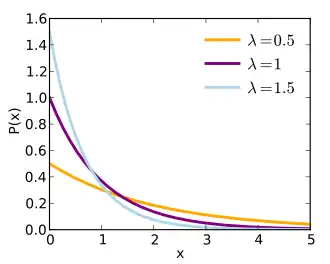Exponential Distribution
Exponential
Probability density function

|
Cumulative distribution function

|
| Parameters
|
λ > 0 rate, or inverse scale
|
| Support
|
x ∈ [0, ∞)
|
| PDF
|
λ e−λx
|
| CDF
|
1 − e−λx
|
| Mean
|
λ−1
|
| Median
|
λ−1 ln 2
|
| Mode
|
0
|
| Variance
|
λ−2
|
| Skewness
|
2
|
| Ex. kurtosis
|
6
|
| Entropy
|
1 − ln(λ)
|
| MGF
|

|
| CF
|

|
Exponential distribution refers to a statistical distribution used to model the time between independent events that happen at a constant average rate λ. Some examples of this distribution are:
- The distance between one car passing by after the previous one.
- The rate at which radioactive particles decay.
For the stochastic variable X, probability distribution function of it is:

and the cumulative distribution function is:

Exponential distribution is denoted as  , where m is the average number of events within a given time period. So if m=3 per minute, i.e. there are three events per minute, then λ=1/3, i.e. one event is expected on average to take place every 20 seconds.
, where m is the average number of events within a given time period. So if m=3 per minute, i.e. there are three events per minute, then λ=1/3, i.e. one event is expected on average to take place every 20 seconds.
Mean
We derive the mean as follows.
![{\displaystyle \operatorname {E} [X]=\int _{-\infty }^{\infty }x\cdot f(x)dx}](../../_assets_/eb734a37dd21ce173a46342d1cc64c92/1c925eb7f3d99af3083ee5838c3bec6f3838997a.svg)
![{\displaystyle \operatorname {E} [X]=\int _{0}^{\infty }x\lambda e^{-\lambda x}dx}](../../_assets_/eb734a37dd21ce173a46342d1cc64c92/de21e0e435a11373f8f68aa9365a100fd28434b7.svg)
![{\displaystyle \operatorname {E} [X]=\int _{0}^{\infty }(-x)(-\lambda e^{-\lambda x})dx}](../../_assets_/eb734a37dd21ce173a46342d1cc64c92/22e2936bccbe650f7919d6dfeb9db772d222f370.svg)
We will use integration by parts with u=−x and v=e−λx. We see that du=-1 and dv=−λe−λx.
![{\displaystyle \operatorname {E} [X]=\left[-x\cdot e^{-\lambda x}\right]_{0}^{\infty }-\int _{0}^{\infty }(e^{-\lambda x})(-1)dx}](../../_assets_/eb734a37dd21ce173a46342d1cc64c92/3e0a325796212c52d7cc34c2e57e5e0a5869121f.svg)
![{\displaystyle \operatorname {E} [X]=[0-0]+\left[{-1 \over \lambda }(e^{-\lambda x})\right]_{0}^{\infty }}](../../_assets_/eb734a37dd21ce173a46342d1cc64c92/fcfc71b113a0864019d9801c659d3ac3294525e2.svg)
![{\displaystyle \operatorname {E} [X]=\left[0-{-1 \over \lambda }\right]}](../../_assets_/eb734a37dd21ce173a46342d1cc64c92/bcc46e6600d22129f1f8916bd6bcfa332679719e.svg)
![{\displaystyle \operatorname {E} [X]={1 \over \lambda }}](../../_assets_/eb734a37dd21ce173a46342d1cc64c92/bf488e5f107cc237b5235226664cf3b1d5c02bcd.svg)
Variance
We use the following formula for the variance.
![{\displaystyle \operatorname {Var} (X)=\operatorname {E} [X^{2}]-(\operatorname {E} [X])^{2}}](../../_assets_/eb734a37dd21ce173a46342d1cc64c92/cd5a922df13bdee788c0f06474fe002a42c25d8a.svg)


We'll use integration by parts with  and
and  . From this we have
. From this we have  and
and  .
.
![{\displaystyle \operatorname {Var} (X)=\left\{\left[-x^{2}\cdot e^{-\lambda x}\right]_{0}^{\infty }-\int _{0}^{\infty }(e^{-\lambda x})(-2x)dx\right\}-{1 \over \lambda ^{2}}}](../../_assets_/eb734a37dd21ce173a46342d1cc64c92/6aa497aeeb4e8301234482593735ec9726a74a95.svg)
![{\displaystyle \operatorname {Var} (X)=[0-0]+{2 \over \lambda }\int _{0}^{\infty }x\lambda e^{-\lambda x}dx-{1 \over \lambda ^{2}}}](../../_assets_/eb734a37dd21ce173a46342d1cc64c92/620c93fc59bb00faabfa622a4b600f2a0dc8ac42.svg)
We see that the integral is just ![{\displaystyle \operatorname {E} [X]}](../../_assets_/eb734a37dd21ce173a46342d1cc64c92/44dd294aa33c0865f58e2b1bdaf44ebe911dbf93.svg) which we solved for above.
which we solved for above.


External links

